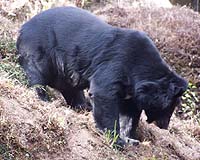| . |  |
. |
Washington DC (SPX) Sep 28, 2010 "A giant rhino with a ridiculously supersized head. Fifteen long, pointed sideways oriented eye horns: one over the nose, one atop each eye, one at the tip of each cheek bone, and ten across the rear margin of the bony frill. A horned face: large horn over the nose and short, blunt eye horns that project strongly to the side" Such phrases have been used to describe two newly discovered species of dinosaurs with looks only a mother could love. Still, they are drawing the attention and inspiring the imagination of scientists and lay people alike. Announced in PLoS ONE, the online open-access journal produced by the Public Library of Science, two new species of horned dinosaurs--Utahceratops gettyi and Kosmoceratops richardsoni--have been found in Grand Staircase-Escalante National Monument in southern Utah. Close relatives of the famous Triceratops, these giant plant eaters were once inhabitants of the "lost island continent" of Laramidia, a swampy, subtropical setting formed when a shallow sea flooded the central region of North America, isolating the eastern and western portions of the continent for millions of years during the late Cretaceous period. "My enthusiasm for these findings is threefold," said Raymond Bernor, program director of the Sedimentary Geology and Paleobiology Program at the National Science Foundation (NSF). "First, researchers discovered two new, exciting dinosaur species. Second, the research has accomplished a major advance in understanding the biogenographic provinciality of Western North American dinosaur communities that apparently included separate northern and southern populations. And third, this discovery has inspired future discoveries in the Grand Staircase-Escalante National Monument, which has now emerged as one of the most important paleontological reserves in the world." But what about these ugly, horned creatures ... Although much speculation has ensued about the function of the ceratopsian horns and frills of these prehistoric monsters--from fighting off predators to recognizing other members of the same species or controlling body temperature--the dominant idea today is that these features functioned first and foremost to enhance reproductive success. Scott Sampson, first author on the paper, explains, "Most of these bizarre features would have made lousy weapons to fend off predators. It's far more likely that they were used to intimidate or do battle with rivals of the same sex, as well as to attract individuals of the opposite sex."
Share This Article With Planet Earth
Related Links National Science Foundation - NSF Darwin Today At TerraDaily.com
 Reformed hunter battles to save Bangladesh's wildlife
Reformed hunter battles to save Bangladesh's wildlifeSrimongal, Bangladesh (AFP) Sept 27, 2010 Sitesh Ranjan Deb says his transformation from hunter to conservationist was triggered 20 years ago when he was attacked by a Himalayan black bear while out stalking deer. Sitesh, from northeastern Bangladesh, stumbled on the sleeping beast. It lashed out, severely damaging his face and one eye, and only emergency surgery saved his life. During many long months of recovery, Sitesh decide ... read more |
|
| The content herein, unless otherwise known to be public domain, are Copyright 1995-2010 - SpaceDaily. AFP and UPI Wire Stories are copyright Agence France-Presse and United Press International. ESA Portal Reports are copyright European Space Agency. All NASA sourced material is public domain. Additional copyrights may apply in whole or part to other bona fide parties. Advertising does not imply endorsement,agreement or approval of any opinions, statements or information provided by SpaceDaily on any Web page published or hosted by SpaceDaily. Privacy Statement |